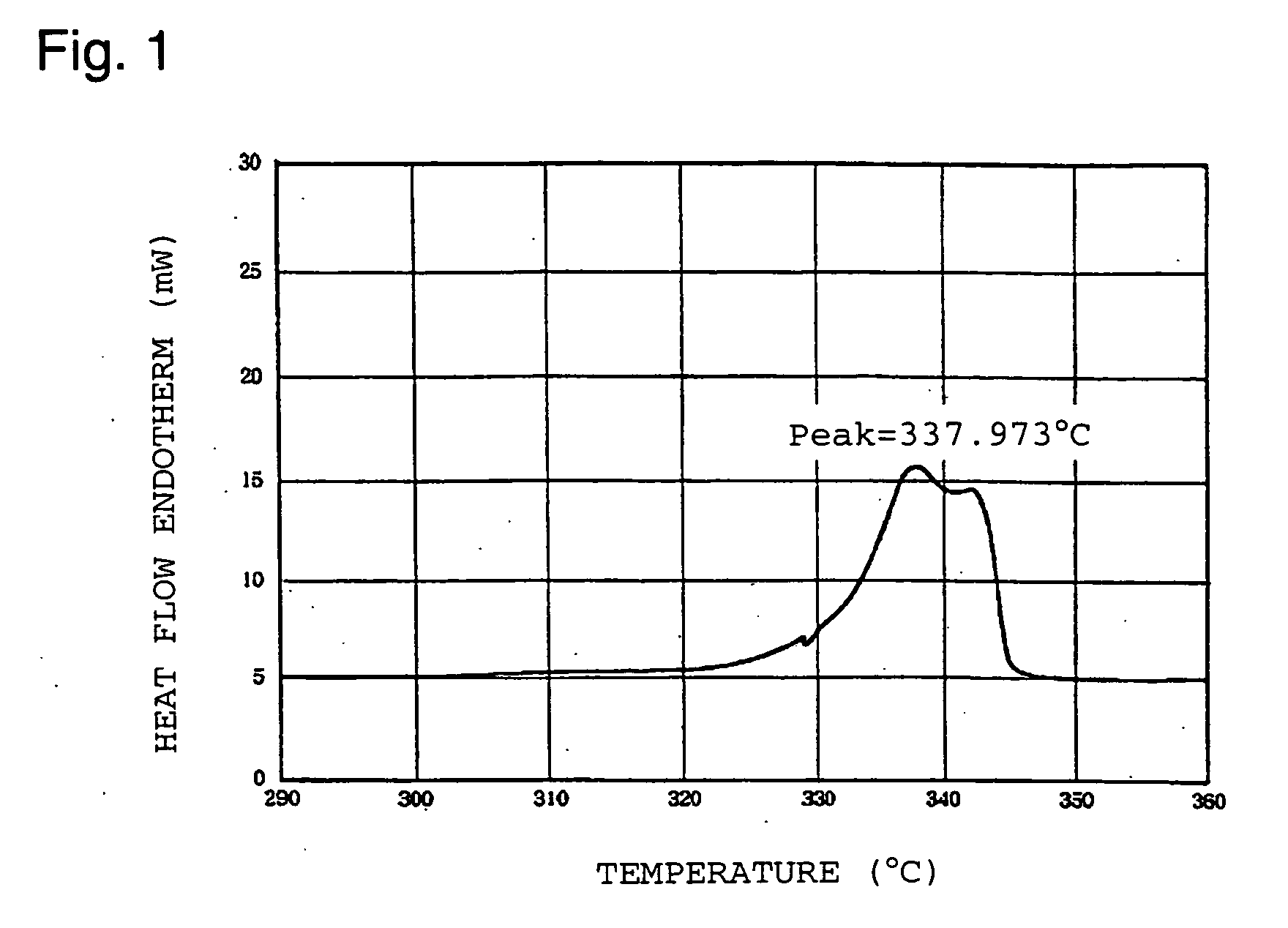Tetrafluoroethylene copolymer, its production method and paste extruded product
- Summary
- Abstract
- Description
- Claims
- Application Information
AI Technical Summary
Benefits of technology
Problems solved by technology
Method used
Image
Examples
example 1
Charged into a 100 L stainless steel autoclave equipped with a baffle plate and a stirrer were 6 g of ammonium perfluorooctanoate, 565 g of paraffin wax and 60 liters of deionized water. The air in the autoclave was replaced with nitrogen and then the pressure was reduced. 42 g of a comonomer CF2═CF—O—CF2CF2CF═CF2 (hereinafter referred to as “PFBVE”) was charged into the autoclave. The pressure was increased with TFE and the temperature was raised to 67° C. under stirring. Then the pressure was raised to 1.85 MPa with TFE and 5.0 g of disuccinic acid peroxide and 0.28 g of ammonium persulfate dissolved in warm water at about 70° C. were injected into the autoclave. The inner pressure decreased to 1.83 MPa in about 4 minutes. Polymerization was made to proceed while adding TFE to keep inner pressure of the autoclave at 1.85 MPa. 84 g of ammonium perfluorooctanoate was introduced at a point where the amount of TFE added reached 3.0 kg. 4 g of methanol and 3.2 g of ammonium persulfate...
example 2
Charged into a 100 L stainless steel autoclave equipped with a baffle plate and a stirrer were 6 g of ammonium perfluorooctanoate, 565 g of paraffin wax and 60 liters of deionized water. The air in the autoclave was replaced with nitrogen and then the pressure was reduced. 47 g of PFBVE was charged into the autoclave. The pressure was increased with TFE and the temperature was raised to 67° C. under stirring. Then the pressure was raised to 1.85 MPa with TFE and 5.0 g of disuccinic acid peroxide and 0.21 g of ammonium persulfate dissolved in warm water at about 70° C. were injected into the autoclave. The inner pressure decreased to 1.83 MPa in about 4 minutes. Polymerization was made to proceed while adding TFE to keep the inner pressure of the autoclave at 1.85 MPa.
84 g of ammonium perfluorooctanoate was introduced at a point where the amount of TFE added reached 3.4 kg. 4 g of methanol and 3.2 g of ammonium persulfate dissolved in pure water at an ordinary temperature were add...
example 3
The reaction was carried out in the same manner as in Example 2 except that 62 g of PFBVE was charged. The polymerization period was about 4 hours. It was confirmed by the gas chromatography analysis that the peak of PFBVE disappeared from the vapor phase in the autoclave at the time of completion of the polymerization. The emulsified dispersion liquid of the TFE copolymer thus obtained was cooled and the supernatant paraffin wax was removed. The emulsified dispersion liquid had a solid content of about 36% by mass. The polymer had an average primary particle size of 0.20 μm. This emulsified dispersion liquid was diluted with pure water to a concentration of 12% by mass, and adjusted to 30° C. and stirred, thereby obtaining a wet fine powder. Then the powder was dried at 120° C. The fine powder of TFE copolymer obtained has an average particle size of 630 μm and a bulk density of 0.47 g / ml. The powder had a standard specific gravity of 2.173 and a TII was −1, thus showing good heat...
PUM
| Property | Measurement | Unit |
|---|---|---|
| Length | aaaaa | aaaaa |
| Fraction | aaaaa | aaaaa |
| Percent by mass | aaaaa | aaaaa |
Abstract
Description
Claims
Application Information
 Login to View More
Login to View More - R&D
- Intellectual Property
- Life Sciences
- Materials
- Tech Scout
- Unparalleled Data Quality
- Higher Quality Content
- 60% Fewer Hallucinations
Browse by: Latest US Patents, China's latest patents, Technical Efficacy Thesaurus, Application Domain, Technology Topic, Popular Technical Reports.
© 2025 PatSnap. All rights reserved.Legal|Privacy policy|Modern Slavery Act Transparency Statement|Sitemap|About US| Contact US: help@patsnap.com

